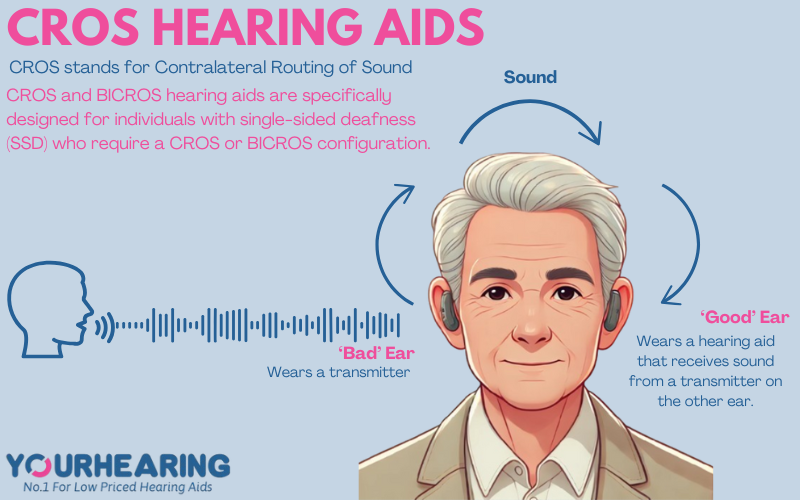CROS / BiCROS Hearing Aids
CROS and BiCROS hearing aids are specifically designed for individuals with single-sided deafness (SSD) who require a CROS or BiCROS configuration. These hearing aids are designed to enhance your listening experience, providing exceptional sound quality from the moment they are used.
How do CROS hearing aids work?
With a CROS hearing aid system, the user will wear a transmitter on the ‘bad’ ear to capture sound. On the ‘good’ ear, a receiver and microphone will be used. These components work together to transmit sound from the bad ear directly into the good ear.


How does BICROS work?
BiCROS hearing aids closely resemble CROS hearing aids but are specifically designed for individuals who experience hearing loss in their "good" ear as well.
In a BiCROS system, the device in your stronger ear will be adjusted to provide any necessary amplification. The “Bi” stands for Bilateral.
Advantages of CROS hearing aids
- Enhanced Sound Awareness - The CROS hearing aid transmits sound from your non-hearing ear to your hearing ear, which enhances your awareness of sounds and improves your perception of warning signals.
- Experience Sounds from Both Sides - CROS hearing aids allow you to hear sounds from both sides of your head without needing to turn. This feature can help reduce feelings of isolation and ensure you don't miss conversations occurring from your weaker side.
- Reduces head-shadow effect - CROS hearing aids can effectively reduce the head-shadow effect, which happens when sounds from the side of your weaker ear are obstructed by your head, preventing them from reaching your stronger ear.
Disadvantages of CROS hearing aids
- Dependency on the ‘good’ ear – As the hearing ear is doing all the work it can become tired and can lead to auditory fatigue
Auditory fatigue, commonly referred to as listening fatigue, is a sensation of tiredness or discomfort that may arise after prolonged exposure to sound. This condition can impact anyone, regardless of whether they experience hearing loss.
- Not effective in noisy environments – When a user is in a loud and noisy environment, they may struggle to comprehend what is being said due to numerous distractions.
- Batteries life - CROS hearing aid batteries generally have a lifespan of just 2 to 3 days.
- Adjustment Challenges - CROS hearing aids may present more difficulties in terms of adjustment and maintenance compared to other types of hearing aids.
Advantages of BiCROS hearing aids
- Customisation – Contemporary systems enable precise adjustments to cater to individual hearing needs.
- Improved Communication - Helps individuals with hearing loss in both ears engage in conversations more effectively.
- Listening from Both Sides - You can detect sounds from both directions without needing to turn your head, which helps you avoid missing conversations happening on your weaker side.
- Enhanced Speech Comprehension - You can understand speech more effectively, even in noisy surroundings.
- Heightened Awareness of Warning Signals - You can better notice warning signals coming from your weaker side.
- Decreased Sense of Isolation - You may experience a reduced feeling of isolation on your weaker side.
- Greater Awareness of Surrounding Sounds - You can become more attuned to various sounds in your environment.
Disadvantages of CROS hearing aids
- Background Noise: BiCROS hearing aids might struggle in loud settings. If the ear with hearing difficulties is directed towards the noise, it could become more challenging to hear clearly.
- Appearance: Some users may find the design of the devices unappealing, leading them to prefer a more discreet style of hearing aid.
- Cost - The BiCROS hearing aids tend to be pricier than traditional hearing aids, which may be difficult for some users to justify.
To find out more about CROS or BiCROS hearing aids and many of the other hearing aid types available contact our experts today. We can also arrange for your free hearing test with one of our network of qualified local audiologists. To View full details of other types of Hearing Aid in more detail, learn more by clicking on the links below
- Behind The Ear Hearing Aids (BTE)
- Open and Receiver In Canal Hearing Aids (Open / RIC)
- In The Ear Hearing Aids (ITE)
- In The Canal Hearing Aids (ITC)
- Invisible In the Canal Hearing Aids (IIC)
- Super Power Hearing Aids
For more of a summary of each type of hearing aid available and what each represents you can view more by click the link.

